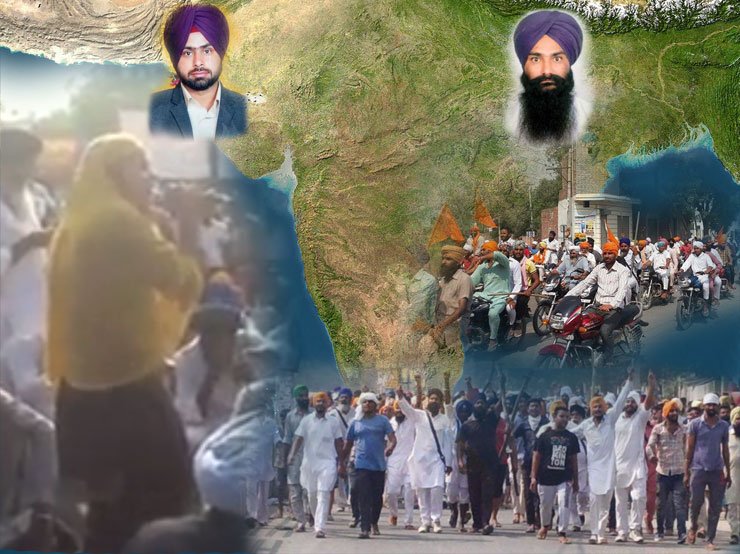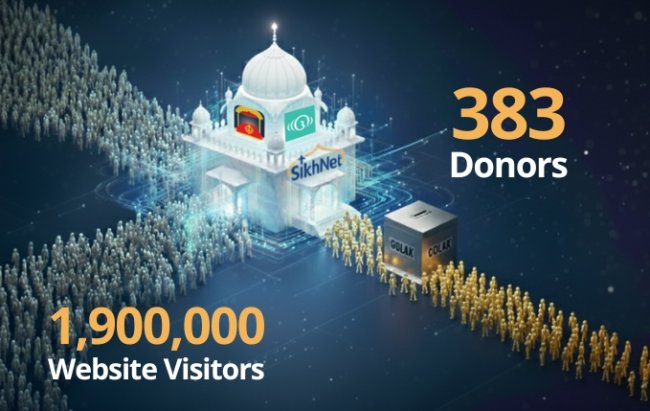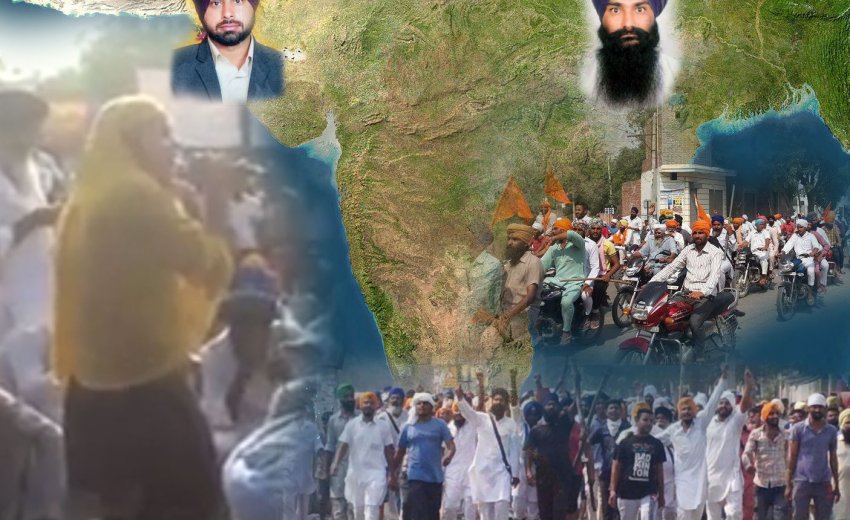Editor's note: The following article has been provided by an individual contributor. The opinions expressed are of the author's and are offered for consideration to all.
As someone who is majoring in the sphere of politics, I have spent a long time following and understanding the politics of Punjab. However after the recent Faridkhot protests I decided to write about how Punjab got to this point. My parents immigrated from there, however I have not been there since I was two years old. I have no attachment to the land and to the culture, however I am a Sikh and Punjab is the land of our origin. I grew up hearing about all 1984, Jallianwala Bagh Massacre, Anglo-Sikh War or the Mughals' affairs with the Gurus and the Panth (Sikh community). So there is my bit of disclosure before I take on the topic at hand.

One must realize the
nation-states of India and Pakistan did not exist at all before the
British gave them legitimacy in 1947. Previously the British had
colonized the subcontinent of South Asia and referred to it as
“British Raj India” because it was seen as one collective colony.
Nine decades of power sure leaves an imprint. Previous to this, there
were many kingdoms as well as splits in culture and language. When
the government of India and Pakistan were formed they declared a
national language for each. The reason why I speak of both countries
is because they were never separate previously.
So the
issue that arose post-independence was all the cleavages in the
countries. Not everyone spoke Hindi or Urdu. For Pakistan there was
an official state religion, which was Islam. In India there was an
unofficial one, Hinduism. India is still referred to by many as
Hindustan (land of the Hindus.) However, during Independence, many
Muslims from the Indian side were forced to Pakistan and vice versa.
The Muslims and Hindus generally remained in their separate
countries. However Punjab was split into two. This created an
unbalance, because Sikhs have religious landmarks and Gurudwaras in
both India and Pakistan.
For a new government it is
really important to create legitimacy. Sikhs did not have their
mother tongue, Punjabi, or written script Gurmukhi as their official
language until the 1960s, and that came with the sacrifice of land
that originally belonged to the Sikh kingdom. So the Indian
government was already losing footholds with the Sikhs. It should
also be known that the word “Punjab” did not exist until the
reign of Maharaja Ranjit Singh. Of course it has huge religious
heritage for Sikhs. However it should be noted that it is not
as if Punjab is a holy land. There is no land with earthly borders
which Sikhs consider holy. Not all seats of authority (Takhts) are in
Punjab. Currently Sikhs live all over the world. When we hear or say
Raj Karega Khalsa (Khalsa will rule) it should not be taken as us
conquering the world but rather as the Khalsa Panth (Sikh community)
working together to overcome maya (the illusion of the world) and to
be collectively spiritually enlightened, serving and protecting
everyone alike. Although Punjab isn't Sikh land, Muslim land, or for
that matter, anybody's land, it does not give anyone a reason for
treating Sikhs as less than human.
Back
to the point of legitimacy; Punjab (of India) is on the border with
Pakistan and has cultural cleavages that do not allow the Indian
government to assimilate the Punjabi under the central government
completely. There was, and will be, an air of uneasiness between the
region and the central government. During the 1970s and1980s
separatism grew. The Indian government's way of dealing with this was
to hurt the morale of the potential revolution in Punjab. That is why
during the early 1980s Operation Bluestar occurred. A deliberate
attack on the Sikhs Central place of worship just as the Panth (Sikh
community) was growing. It just so happened that while more Sikhs
became Orthodox, the central government took this to mean that there
would be more Sikh nationalism, and this is certainly true. Sikhs in
Punjab were uniting together and felt more of a connection to
themselves than with the rest of India. I have heard someone compare
this operation to be as if the Vatican were to be rushed by Italian
militia, or as if a military force came to attack the Hajj in Mecca.
The same way that people cannot even bear to hear of such things, it
happened with the Sikhs. On top of the innocent civilians killed
going to pray, the entire state of Punjab was on lock down with media
censorship.
After the 1990s, the increase in Orthodox Sikhs
declined and the Khalistan movement was also suppressed because of
lingering hatred towards Sikhs by the general Hindu population of
India. Many Sikhs had moved to other parts of India and the globe to
get away from the aftermath of a messy couple of decades and start
fresh. For the Sikhs that did stay, national television broadcasting
Hindi language movies and national radio with Hindi language songs
did away with traditional Sikh religion. Instead it brought forward
Indian nationalism and put this cultural cleavage into
decline.
Today Sikhism is stagnant in India and instead a
Punjabi culture of alcoholism and drug consumption runs rampant. Many
Sikhs refer to drugs as the sixth river in Punjab (Land of Five
Rivers). The question that many get is: “Why couldn't the central
government allow the Sikhs to flourish and respect them while they
co-existed in India?” The simple answer is politics. The central
government has a Hindu background which focused around a caste system
and patriarchy, and these are practices that didn't bring anyone
closer to God according to Sikhs. Sikhs believe in equality that
brings all humanity together without class differences and in which
women and men are treated equally. If this way of life arose in the
rest of India it would bring down the well held up system the central
Indian government supports.
Today we see another
increase in Sikhi, but from those around the world, not in Punjab.
Social media has allowed information to get across the globe that
media censorship cannot hide. Movies that are about 1984 are blocked
by the government in India. There are millions of people in India who
do not know the truth behind the Anti-Sikh pogroms and Operation
Bluestar, and simply see Sikhs involved around that time as
terrorists. Well, as we know, the stories of the hunt will continued
to be told by the hunters. The sheer fact that the government is
still trying to suppress Sikhs in this day and age, through police
brutality, more media censorship and regional lock down, is enough to
show that this was not an issue of terrorism but rather hegemony over
a minority for territorial control.
Sikhs today do not want
separatism to the same extent as they used to. Sikhs want to be able
to have religious freedom within India. However, when someone steals
Satguru Siri Granth Sahib Ji from its seat at a Gurudwara and then
tears the limbs off Guruji, we cannot help protesting when the police
have not found anything for months. Now Deputy Chief Minister Badal
has offered a reward for Rs. 1 Crores for any leads. It has been
months and people have been killed in last couple of days and now
something is being done about it.
Bapu
Surat Singh is still committed to his hunger strike to release
political prisoners who were locked up because of their nationalism
under laws that no longer exist in the criminal code. All the Panth
needs is a state government that can let them practice Sikhi without
political control over their faith and to see that an accountable,
democratic government can exist without fear of corruption. If they
do not, then the Panth both inside India as well as outside, will be
protesting against the government and its police until Sikhs get what
they deserve: respect and religious freedom.
I hope this was a
helpful political analysis and history lesson of what occurred and is
occurring in Punjab today.

